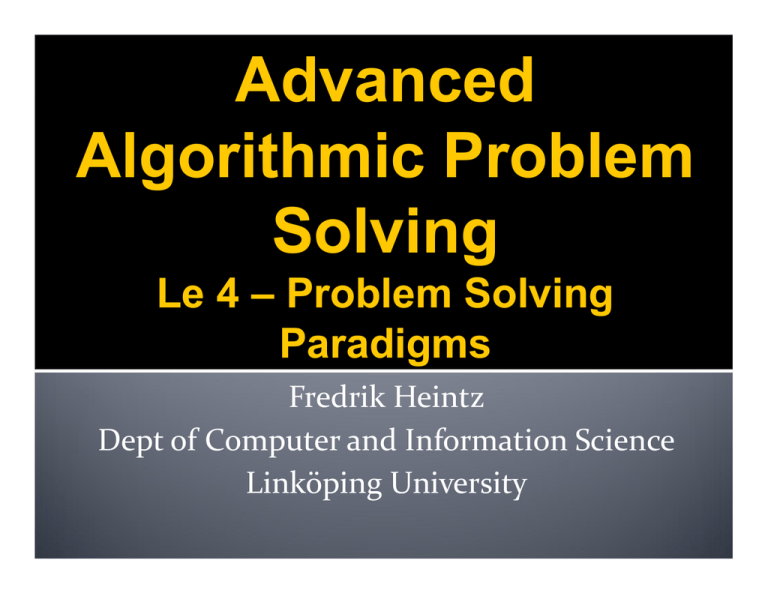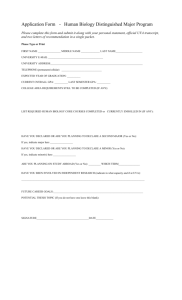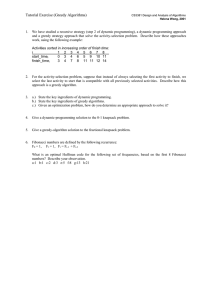Advanced Algorithmic Problem Solving Le 4 – Problem Solving
advertisement

Advanced Algorithmic Problem Solving Le 4 – Problem Solving Paradigms Fredrik Heintz Dept of Computer and Information Science Linköping University Important Problem Solving Approaches 2 Simulation/Ad hoc Do what is stated in the problem Example: Simulate a robot Greedy approaches Find the optimal solution by extending a partial solution by making locally optimal decisions Example: Minimal spanning trees, coin change in certain currencies Divide and conquer Take a large problem and split it up in smaller parts that are solved individually Example: Merge sort and Quick sort Dynamic programming Find a recursive solution and compute it “backwards” or use memoization Example: Finding the shortest path in a graph and coin change in all currencies Search Create a search space and use a search algorithm to find a solution Example: Exhaustive search (breadth or depth first search), binary search, heuristic search (A*, best first, branch and bound) Outline 3 Complete search (iterative and recursive, UVA 11656, UVA 750) Divide and Conquer (binary search, UVA 11935) Greedy search (lab 1.1, UVA 10382) Dynamic programming (lab 1.2, lab 1.3, UVA 147, UVA 11450, UVA 507, UVA 108) Complete Search 4 When a problem is small or (almost) all possibilities have to be tried complete search is a candidate approach. To determine the feasibility of complete search estimate the number of calculations that have to be made in the worst case. Iterative complete search uses nested loops to generate every possible complete solution and filter out the valid ones. Iterating over all permutations using next_permutation Iterating over all subsets using bit set technique Recursive complete search extends a partial solution with one element until a complete and valid solution is found. This approach is often called recursive backtracking. Pruning is used to significantly improve the efficiency by removing partial solutions that can not lead to a solution as soon as possible. In the best case only valid solutions are generated. Divide and Conquer 5 Divide and conquer is very common and powerful technique which divides a problem into smaller parts, solves each part recursively and then puts together the answer from the pieces. Many well known algorithms are based on divide and conquer such as quick sort, merge sort and binary search. Binary search is a very versatile and useful technique which can be used to find a particular value in a sorted range, find the parameters of a (convex) function that gives a particular value, find the minimum/maximum value of a function. Binary search can be implemented either using built in functions (lower_bound/upper_bound), iterating until the difference between the end points is small enough or iterate a constant but sufficiently large number of times. Greedy 6 An algorithm is said to be greedy if it makes a locally optimal choice in each step towards the globally optimal solution. For a greedy algorithm to give a globally optimal result a problem must have two properties: It has optimal sub-structures, i.e. an optimal solution contains the optimal solutions to sub problems. It has the greedy choice property, i.e. if we extend a partial solution by making a locally optimal choice we will get the optimal complete solution without reconsidering previous choices. Classical examples: Coin change in some currencies, interval coverage and load balancing. Greedy algorithms can be very useful as heuristics for example in branch-and-bound search algorithms. In combinatorics matroids and the generalization greedoids characterize classes of problems with greedy solutions. Dynamic Programming 7 Dynamic Programming is a problem solving approach which computes the answer for every possible state exactly once. For DP to be suitable a problem must have two properties: It has optimal sub-structures, i.e. an optimal solution contains the optimal solutions to sub problems. Overlapping sub-problems, i.e. the same subproblem occurs many times. Top-down (memoization) vs Bottom-up Top-down: no need to consider the order of computations, only compute states actually used, natural transition from complete search, Bottom-up: no recursion, computes every state, table size can be reduced if only the previous row of states is used then only two rows are required. Displaying the optimal solution Store the previous state for each solution Use the DP table and the optimal sub-structures property to compute the path. Classical DP Problems 8 Max 1D sum Max 2D sum Longest increasing subsequence (LIS) Longest decreasing subsequence (LDS) 0-1 Knapsack (subset sum) Coin Change (general version) Travelling Salesman Problem (TSP) 1D RSQ 2D RSQ LIS Knapsack CoinChange TSP State (i) (i,j) (i) (id,remW) (v) (pos,mask) Space O(n) O(n2) O(n) O(nS) O(V) O(n2n) Transition subarray submatrix all j<i take/ignore all n coins all n cities Time O(1) O(1) O(n2) O(nS) O(nV) O(2nn2) Summary 9 When a problem is small or (almost) all possibilities have to be tried complete search is a candidate approach. Divide and conquer is very common and powerful technique which divides a problem into smaller parts, solves each part recursively and then puts together the answer from the pieces. An algorithm is said to be greedy if it makes a locally optimal choice in each step towards the globally optimal solution. Dynamic Programming is a problem solving approach which computes the answer for every possible state exactly once.






